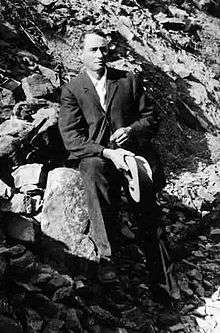Ed Pulaski
| Ed Pulaski | |
|---|---|
 | |
| Born |
Edward Crockett Pulaski February 9, 1866[1] Green Springs, Seneca County, Ohio |
| Died |
February 2, 1931 (aged 64)[1] Coeur d’Alene, Idaho |
| Resting place | Coeur d'Alene, ID, Forest Cemetery, Section E, Block 40, Lot 6 |
| Occupation | Forest Ranger |
| Employer | U.S. Forest Service |
Edward Crockett "Ed" Pulaski (February 9, 1866 – February 2, 1931) was a U.S. Forest Service ranger based in Wallace, Idaho. Pulaski traveled west and worked as a miner, railroad worker, and ranch foreman before joining the forest service in 1908.[2] He was reputed to be, and personally claimed, that he was a collateral descendant of Casimir Pulaski.[3]
Great Fire of 1910
On August 20, 1910, Pulaski was credited with saving all but five of his 45-man crew during what is known as the "Great Idaho Fire," the "Great Fire of 1910" or the "Big Blowup." It had been unusually dry in 1910 and forest fires were rampant across the northern Rockies. Pulaski was supervising crews on the west fork of Placer Creek, about five miles south of Wallace, when the fire suddenly broke out of control, overwhelming the crew.
Drawing on his knowledge of the area and of the dynamics of forest fires, Pulaski led his men to safety in an abandoned prospect mine. After ordering his crew into an abandoned mine tunnel, he threatened to shoot with his pistol any man who left. Lying prone on the tunnel floor, all but five of the firefighters survived. The two horses with them died from smoke inhalation.[4] The mine entrance, now known as the Pulaski Tunnel, is listed on the National Register of Historic Places.[5]
Pulaski firefighting tool
Pulaski is widely credited for the invention of the Pulaski in 1911, a hand tool commonly used in wildland firefighting. A combination hand tool with a mattock for digging or grubbing on one side and an axe for chopping on the other, it is often called a "Pulaski tool".[6][7]
Legacy
Mount Pulaski, a 5480-foot (1670 m) peak 1.5 miles southwest of Wallace, is named for him.
The US Forest Service's Pulaski Tunnel Trail near Wallace, Idaho, provides access to the Nicholson Mine site where Pulaski and his team took shelter.
An initialed ("E.P.") tool, which purportedly belonged to Pulaski himself, is at the Wallace District Mining Museum in Wallace, Idaho in the collection of the Smithsonian Institution.[7][8]
American Singer-Songwriter Steve Earle wrote and recorded a song that largely recounts the story of Ed Pulaski's heroic actions and invention, "The Firebreak Line". It appears on his 2017 album "So You Wannabe An Outlaw".
References
- 1 2 "Idaho Death Index, 1911-51 [database on-line]. Provo, UT, USA". Ancestry.com. Missing or empty
|url=(help);|access-date=requires|url=(help) - ↑ Edward Pulaski - Ranger, Miner, Heroic Firefighter & Inventor at culture.polishsite.us
- ↑ Pyne, Sonia. "Edward Crockett Pulaski: A Short Biography" (PDF). Retrieved 2014-04-02.
- ↑ Egan, Timothy (2009). The Big Burn: Teddy Roosevelt and the Fire That Saved America. Boston: Houghton Mifflin Harcourt. pp. 177–79. ISBN 978-0-618-96841-1.
- ↑ Pyne, Stephen J. (2008). Year of the Fires: The Story of the Great Fires of 1910. Missoula, Montana: Mountain Press Publishing Company. pp. 165–178. ISBN 978-0-87842-544-0.
- ↑ "Breaking New Ground". Archived from the original on May 6, 2006. Retrieved 2007-07-04.
- 1 2 Davis, James B. (1986). "The True Story of the Pulaski Fire Tool" (PDF). Fire Management Notes. US Department of Agriculture Forest Service. 47 (3): 19–21. Retrieved April 22, 2016.
- ↑ "The Pulaski Axe" (Video). Mysteries at the Museum, Season Six. Travel Channel. 2014. Retrieved April 22, 2016.
External links and further information
- Surrounded by Forest Fires - My Most Exciting Experience as a Forest Ranger, by E.C. Pulaski
- The 1910 Fires, a history of the Great Fire of 1910 from the Forest History Society website.
- Take a virtual hike to the Pulaski Tunnel - Virtual tour of the Pulaski Tunnel Trail
- VisitIdaho.org - Pulaski Tunnel Trail
- Idaho Forests.org - The Pulaski Project
- Ed Pulaski at Find a Grave
- Edward Pulaski from www.fs.usda.gov